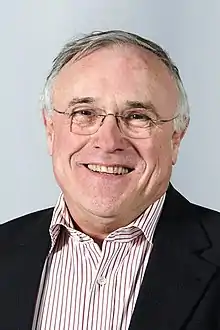Klaus Müllen
Klaus Müllen (born January 2, 1947) is a German chemist working in the fields of polymer chemistry, supramolecular chemistry and nanotechnology. He is known for the synthesis and exploration of the properties of graphene-like nanostructures and their potential applications in organic electronics.
Klaus Müllen | |
|---|---|
 | |
| Born | January 2, 1947 |
| Nationality | German |
| Alma mater | University of Cologne University of Basel |
| Scientific career | |
| Fields | polymer chemistry supramolecular chemistry nanotechnology |
| Institutions | University of Mainz Max Planck Institute for Polymer Research |
| Thesis | Nuclear resonance and electron spin resonance spectroscopic studies on bridged annulenes |
| Academic advisors | Fabian Gerson |
| Doctoral students | Eva Harth |
Early life and education
Müllen was born in Cologne. He studied chemistry there and was awarded a PhD in 1971 under the supervision of Fabian Gerson at the University of Basel. He specialized in electron spin resonance spectroscopy and his dissertation was on nuclear resonance and electron spin resonance spectroscopic studies on bridged annulenes. He then completed post-doctoral studies at the ETH Zurich under Jean François Michel Oth (1926-2003) and received his habilitation in 1977 with a thesis on dynamic NMR spectroscopy and electrochemistry.
Research career
In 1979 he became professor of organic chemistry at the University of Cologne, in 1983 he went to the University of Mainz as a professor. Since 1989 he has been director and scientific member of the Max Planck Institute for Polymer Research. In 2016 he became emeritus. Since 1995 he has been honorary professor at the University of Mainz and at the Gutenberg Research College of the University of Mainz. He is an Associate Editor of the Journal of the American Chemical Society[1]
His research interests are in the field of preparative macro- and supramolecular chemistry. Among other things, his group has succeeded in synthesizing and characterizing hitherto unattainable large polycyclic aromatics such as superphenalene, which has a molecular mass of 1182 g·mol−1 and consists of 34 condensed benzene rings.[2]

He has developed small disc-like organic building blocks using alkyl-substituted hexabenzocoronene, and in particular HBC-C12[3] - which self-assembles into crystalline liquid-phase structures (columnar liquid crystals) as potential organic field-effect transistors.[4] The considered two-dimensional benzene ring structures are examples of subunits of graphene lattices (graphene nanostructures). The graphene-like structures synthesized and investigated by Müllen include two-dimensional bands of less than 50 nanometers width with jagged edges. Of interest here are the electronic conduction properties and spintronics properties with a view to future replacement of silicon-semiconductor technology.[5] In synthesis, he introduced a new method in graphene polymer chemistry: soft-landing mass spectrometry.[6] Applications include synthetic light-emitting organic materials (such as OLEDs) and incorporation of molecular defects (defect engineering) organic analogues of semiconductor technology.
Selected awards and honorary posts
- 2017: Member of the Academia Europaea[7]
- 2017: Hamburger Wissenschaftspreis (shared with Xinliang Feng)[8]
Selected publications
- Books
- K. Müllen: Kernresonanz- und elektronenspinresonanzspektroskopische Untersuchungen an überbrückten Annulenen, Dissertation, Basel 1971
- K. Müllen and G. Wegner: Electronic materials: the oligomer approach, Wiley-VCH-Verlag, Weinheim 1998, ISBN 3-527-29438-4
- K. Müllen and U. Scherf: Organic light emitting devices: synthesis, properties and applications, Wiley-VCH-Verlag, Weinheim 2006, ISBN 3-527-31218-8
- Articles
- Evolution of Graphene Molecules: Structural and Functional Complexity as Driving Forces behind Nanoscience, ACS Nano, 2014, 8, 6531–6541
- Molecular defects in organic materials, Nature Reviews Materials, 2016, 1, 15013
- with Giovanna De Luca et al.: Non-conventional Processing and Post-processing Methods for the Nanostructuring of Conjugated Materials for Organic Electronics, Advanced Functional Materials, 2011, 21, 1279–1295
- with J. Wu, W. Pisula: Graphenes as Potential Material for Electronics, Chemical Reviews, 2007, 107, 718–747
- with Wang, Xuan; Zhi, Linjie: Transparent, conductive graphene electrodes for dye-sensitized solar cells, Nano Letters, Volume: 8 (2008), 323–327
- with Jinming Cai, Pascal Ruffieux, Rached Jaafar et al.: Atomically precise bottom-up fabrication of graphene nanoribbons, Nature 466 (2010) 470–473
- with Zhong-Shuai Wu, Shubin Yang, Yi Sun et al.: 3D Nitrogen-Doped Graphene Aerogel-Supported Fe3O4 Nanoparticles as Efficient Eletrocatalysts for the Oxygen Reduction Reaction, J. Am. Chem Soc. 134 (2012) 9082–9085
- with Anika Kinkhabwala, Zongfu Yu, Shanhui Fan et al.: Large single-molecule fluorescence enhancements produced by a bowtie nanoantenna, Nature Photonics 3 (2009) 654–657
- with M. D. Watson, A. Feuchtenkotter: Big is beautiful - "Aromaticity" revisited from the viewpoint of macromolecular and supramolecular benzene chemistry, Chemical Reviews 101 (2001) 1267–1300
- with Ruili Liu, Dongging Wu, Xinliang Feng: Nitrogen-Doped Ordered Mesoporous Graphitic Arrays with High Electrocatalytic Activity for Oxygen Reduction, Angewandte Chemie – International Edition 49 (2010) 2565–2569
References
- "Journal of the American Chemical Society Editorial Board". www.pubs.acs.org. American Chemical Society. Retrieved 30 July 2019.
- From Hexa‐peri‐hexabenzocoronene to “Superacenes”
- Hexakis(n-dodecyl)-peri-hexabenzocoronene, dodecyl-substituted hexabenzocoronene.
- H. N. Tsao, H. J. Räder, W. Pisula, A. Rouhanipour, K. Müllen: Novel organic semiconductors and processing techniques for organic field-effect transistors, physica status solidi, 2008, 205, 421–429.
- GRC Fellow Klaus Müllen receives Hermann Staudinger Award 2016.
- Hans Joachim Räder, Ali Rouhanipour, Anna Maria Talarico, Vincenzo Palermo, Paolo Samorì, Klaus Müllen, Processing of giant graphene molecules by soft-landing mass spectrometry, Nature Materials, 2006, 5, 276–280, Abstract.
- Academy of Europe Müllen Klaus accessed July 30, 2019
- Hamburg Science Award 2017 goes to Klaus Müllen and Xinliang Feng Pressemitteilung der Universität Dresden vom 26. Juni 2017 accessed on 26 December 2017.